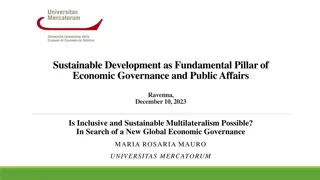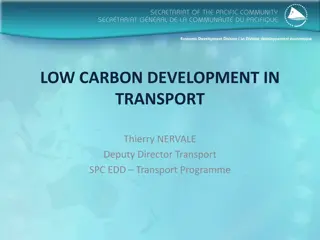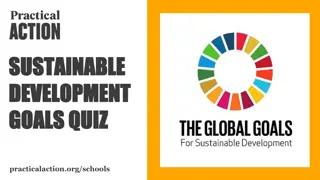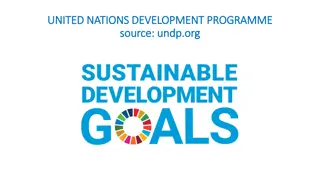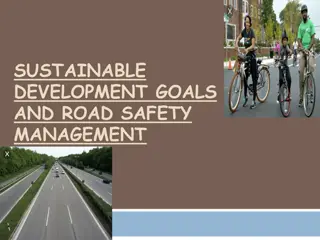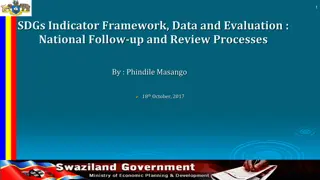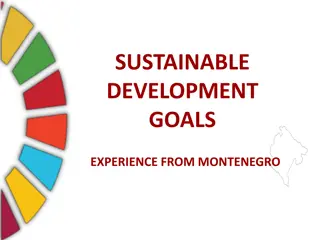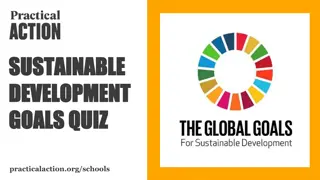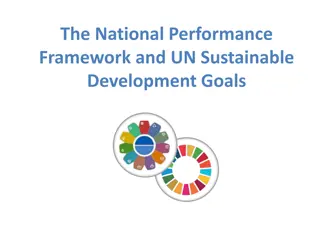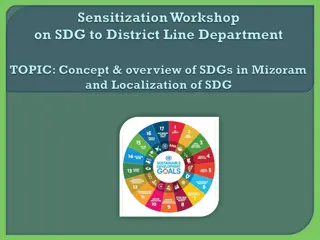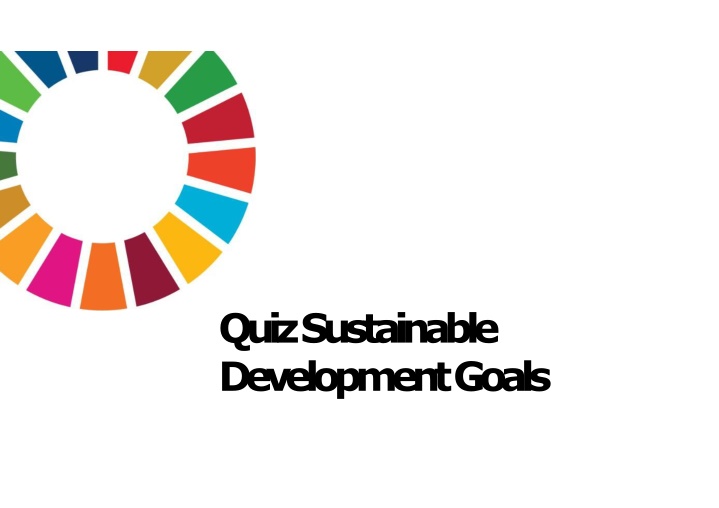
Quiz on Sustainable Development Goals
Engage in a quiz testing your knowledge on global issues such as poverty, malnutrition, and life expectancy. Explore key statistics and facts related to Sustainable Development Goals. Challenge yourself to learn more about important world matters!
Download Presentation

Please find below an Image/Link to download the presentation.
The content on the website is provided AS IS for your information and personal use only. It may not be sold, licensed, or shared on other websites without obtaining consent from the author. If you encounter any issues during the download, it is possible that the publisher has removed the file from their server.
You are allowed to download the files provided on this website for personal or commercial use, subject to the condition that they are used lawfully. All files are the property of their respective owners.
The content on the website is provided AS IS for your information and personal use only. It may not be sold, licensed, or shared on other websites without obtaining consent from the author.
E N D
Presentation Transcript
Quiz Sustainable Development Goals
QUESTION1 In 1990, almost 2 billion people lived in extreme poverty, i.e. on less than US$ 1.9 a day. Approximately how many people lived in extreme poverty in 2023?
QUESTION1 In 1990, almost 2 billion people lived in extreme poverty, i.e. on less than US$ 1.9 a day. Approximately how many people lived in extreme poverty in 2023? 2,0billion 685million 2,8billion
QUESTION1 In 1990, almost 2 billion people lived in extreme poverty, i.e. on less than US$ 1.9 a day. Approximately how many people lived in extreme poverty in 2023? 685millionpeople
QUESTION2 About 10% of the world's population suffers from malnutrition. In which part of the world do most malnourished people live?
QUESTION2 About 10% of the world's population suffers from malnutrition. In which part of the world do most malnourished people live? South America Africa Asia
QUESTION2 About 10% of the world's population suffers from malnutrition. In which part of the world do most malnourished people live? Asia
QUESTION3 In 1960, the average life expectancy in the world was 52 years. What was the average life expectancy of the world's population in 2023?
QUESTION3 In 1960, the average life expectancy in the world was 52 years. What was the average life expectancy of the world's population in 2023? 73years 55years 63years
QUESTION3 In 1960, the average life expectancy in the world was 52 years. What was the average life expectancy of the world's population in 2023? 73years
QUESTION4 In 1980, approximately 44% of the world's population was illiterate. Approximately what proportion of the world's population was illiterate in 2023?
QUESTION4 In 1980, approximately 44% of the world's population was illiterate. Approximately what proportion of the world's population was illiterate in 2023? 5% 13% 35%
QUESTION4 In 1980, approximately 44% of the world's population was illiterate. Approximately what proportion of the world's population was illiterate in 2023? 13%
QUESTION5 Norway got its first female mayor in 1926. How many of the country's 428 mayors were women after the municipal elections in 2019?
QUESTION5 Norway got its first female mayor in 1926. How many of the country's 428 mayors were women after the municipal elections in 2019? 80 126 220
QUESTION5 Norway got its first female mayor in 1926. How many of the country's 428 mayors were women after the municipal elections in 2019? 126
QUESTION6 Thanks to efforts over time, 73% of the world's population had access to clean drinking water by 2023. But how many people in the world do not have access to safe toilet conditions?
QUESTION6 Thanks to efforts over time, 73% of the world's population had access to clean drinking water by 2023. But how many people in the world do not have access to safe toilet conditions? Less than 0,5billion Over 3,5 billion 1billion
QUESTION6 Thanks to efforts over time, 73% of the world's population had access to clean drinking water by 2023. But how many people in the world do not have access to safe toilet conditions? Over 3,5 billion people
QUESTION7 Hydropower accounts for 90% of Norway's power production. Approximately how many hydropower plants are there in Norway?
QUESTION7 Hydropower accounts for 90% of Norway's power production. Approximately how many hydropower plants are there in Norway? 500 1000 1800
QUESTION7 Hydropower accounts for 90% of Norway's power production. Approximately how many hydropower plants are there in Norway? 1800
QUESTION 8 The fight against child labor is high on the political agenda. In the year 2000, there were around 250 million child workers in the world. Approximately how many child workers were there in the world in 2024?
QUESTION8 The fight against child labor is high on the political agenda. In the year 2000, there were around 250 million child workers in the world. Approximately how many child workers were there in the world in 2024? 160million 250million 350million
QUESTION 8 The fight against child labor is high on the political agenda. In the year 2000, there were around 250 million child workers in the world. Approximately how many child workers were there in the world in 2024? 160million
QUESTION9 Norway is one of the countries where most residents are online - in fact as much as 97% per 2020. But this is not the case all over the world. Approximately what proportion of the world's population had access to the internet in 2024?
QUESTION9 Norway is one of the countries where most residents are online - in fact as much as 97% per 2020. But this is not the case all over the world. Approximately what proportion of the world's population had access to the internet in 2024? 30% 66% 70%
QUESTION9 Norway is one of the countries where most residents are online - in fact as much as 97% per 2020. But this is not the case all over the world. Approximately what proportion of the world's population had access to the internet in 2024? 66%
QUESTION 10 The gap between the world's richest and the world's poorest is increasing. How much of the world's wealth does the world's richest 1% own?
QUESTION10 The gap between the world's richest and the world's poorest is increasing. How much of the world's wealth does the world's richest 1% own? 65 % 30 % 45 %
QUESTION 10 The gap between the world's richest and the world's poorest is increasing. How much of the world's wealth does the world's richest 1% own? 45 % oftheworld s wealth
QUESTION11 There is increasing political will to phase out diesel cars in city traffic, as they have a high emission of NOx gases. Which two elements are included in a NOx gas?
QUESTION11 There is increasing political will to phase out diesel cars in city traffic, as they have a high emission of NOx gases. Which two elements are included in a NOx gas? Neon and osmium Nitrogen and oxygen Nickel and xenon
QUESTION11 There is increasing political will to phase out diesel cars in city traffic, as they have a high emission of NOx gases. Which two elements are included in a NOx gas? Nitrogen og oxygen
QUESTION12 According to the Ministry of the Environment, Norway throws away 450,000 tonnes of food annually, which corresponds to approx. 85 kg per consumer. Where does the biggest food waste take place?
QUESTION12 According to the Ministry of the Environment, Norway throws away 450,000 tonnes of food annually, which corresponds to approx. 85 kg per consumer. Where does the biggest food waste take place? In households In grocery stores In restaurants

